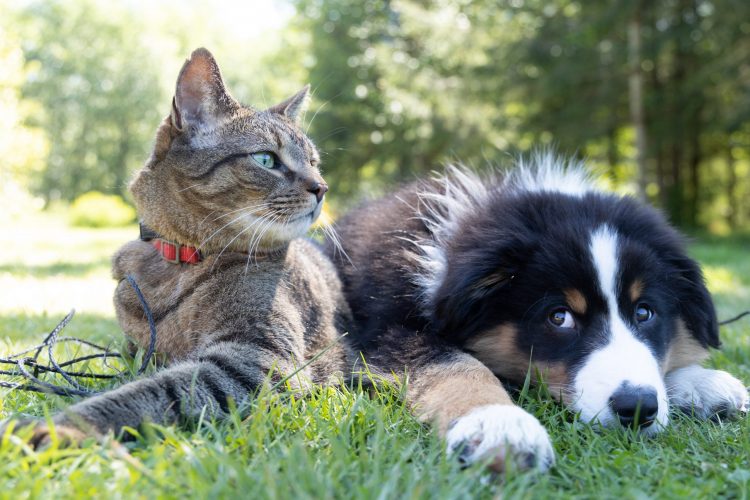
The debate between dog and cat owners is nearly as old as time itself. Dog lovers believe their canine companions are smarter and more obedient than cats, and cat aficionados feel their feline friends are more sophisticated, independent, and have more couth than dogs. Undoubtedly, there are pros and cons for each species, but the bottom line is; there is typically a personality and lifestyle match for everyone.
Odds are that nearly everyone has been asked at one time or another to ponder this loaded question: Are you a dog or cat person? Taking into consideration all the differences in living requirements, behaviors, personalities, sounds, habits, instincts, interests, and so on, it’s understandable that there are many differences between cats and dogs and that the question above makes for interesting conversation, to say the least.
Most people grow up with either dogs or cats. But some families live with both. Yet, many people grow up with neither and this article may help with their decision on which species to bring into their home as a new member of the family. There are undoubtedly many differences between cats and dogs, and some characteristics may suggest a better fit for one species over the other for certain individuals. Hopefully, the information below will aid the process of deciding if you are a dog or cat person…or both.
Behavior
From the vastly dissimilar sounds dogs and cats make to their varying instincts and daily habits, the general behavior between the two species is completely different. Dogs are most active during the day and cats are most lively at night. Dog owners are loving the pandemic-induced work from home routines because their faithful companions make good company during the day, encouraging petting breaks, walks, fetch sessions, and offering comforting companionship. Dogs are helping us stay focused and encouraging us to get more exercise. Here are 15 Ways Dogs Impact Our Lives More Than We Realize.
Cats offer companionship as well, but typically at a much lower intensity during the day as they “cat nap”. Cats have “purrfected” the art of lazy lounging. However, they make up for lost time at night, which is perfect for those night owls in our pet parent population. Here are the Top 15 Reasons to Adopt a Cat from a Shelter
When it comes to sounds, we all know that dogs bark and cats meow. But each has unique variations such as a dog’s howl, growl, whine, or whimper, or a cat’s harmless chirrups or meaner snarls, hisses, or spitting if they feel threatened.
Dogs encourage us to become more active since they love walks, playing fetch and when trained properly… running. Cats love to be outdoors as well, but typically on their own and not as much with their pet parent. And since cats tend to sleep away their daytime hours, they aren’t quite as encouraging as our canine companions in getting us moving.
When protecting themselves or their owners, cats and dogs again display different behavior. Cats will arch their back, display dilated pupils, and even move their tails in erratic directions. Dogs, on the other hand, will growl, bark, bare their teeth and stare at their enemy.
Besides both being furry, the physical difference between canines and felines is very obvious. Cats are typically much smaller than most dogs, but are more agile, can jump much higher, and can scale to great heights when necessary. A cat’s claws are very sharp and retractable and provide for increased agility and protection. Here are some tips on Cutting a Cat’s Claws – The How and Why. A dog’s claws are not near as sharp because they can’t retract and tend to wear down due to frequent walks and outings.
Dogs and cats are excellent hunters, but they stalk their prey in very different ways. Cats are climbers and tend to approach their victims from high places, whereas dogs remain grounded and use their noses and speed to find their target.
While dogs have 42 adult teeth, cats only need 30 to get the job done. Cat teeth are very sharp and tend to protrude more and are sharper as a whole compared to a dog’s teeth.
Cat fur is typically finer than both dog and human hair and cats are typically quieter and cleaner than dogs as a whole.
Training
One of the biggest differences seen between cats and dogs is the training that can be instilled in both. Cats are trainable; however, they are independent thinkers and like to often express their opinion. Dogs are pack animals who are very inclined to follow their alpha’s requests. Cats not so much. Since cats aren’t pack animals, they certainly don’t do well in group training sessions like dogs do. Dogs can survive much longer training sessions than cats, but a cat’s memory lasts longer than that of a dog, so consistency and short-duration training sessions for cats are best.
Food
While dogs and cats both enjoy mealtime, the way they eat is completely different. A cat can eye a bowl full of food and gradually graze on it all day whenever it desires. Cats can regulate how much they eat in one sitting, whereas dogs are typically not so lucky. If you place a full bowl of food in front of your pooch, it will more than likely disappear in a matter of minutes.
 Cat food features a higher calorie content than dog food and a cat’s menu is typically high in protein, fat, essential minerals, and vitamins. It also consists of smaller pieces compared to dog food to more comfortably fit in their smaller mouths and to help protect their very sharp teeth. Cats are carnivorous and thus sensitive to receiving the right balance of nutrients…much more so than dogs. For example, if a cat occasionally eats some dog food, it’s fine, but eating too much will deprive the feline of essential elements needed to sustain a good quality of life.
Cat food features a higher calorie content than dog food and a cat’s menu is typically high in protein, fat, essential minerals, and vitamins. It also consists of smaller pieces compared to dog food to more comfortably fit in their smaller mouths and to help protect their very sharp teeth. Cats are carnivorous and thus sensitive to receiving the right balance of nutrients…much more so than dogs. For example, if a cat occasionally eats some dog food, it’s fine, but eating too much will deprive the feline of essential elements needed to sustain a good quality of life.
Since dogs are omnivorous, a canine’s digestive system isn’t as sensitive as a cat’s and thus allows for more variation in diet. Here are 50 Fruits and Vegetables Dogs Can and Can’t Eat. Just make sure a dog doesn’t eat cat food since fish-based cat food can contain a good amount of vitamin D and dogs can’t handle near as much vitamin D as cats can. Most dogs do good on a commercial diet, but if you are wanting to customize your canine’s diet, here are some Homemade Dog Food & Treats – Pros and Cons.
Cats usually consume more frequent and smaller meals than dogs, but they do enjoy eating just like dogs. Cat food is more delicately produced to help protect a cat’s finely honed teeth, whereas dog food typically comes in larger chunks since a dog’s teeth are less susceptible to damage from hard food.
Coming from a pack mentality where if you don’t consume as much as you can, the rest of the pack will, it’s easy to see why canines “wolf down” their food much like a ravenous wild wolf.
Body Language
Both dogs and cats exhibit unique body language to telegraph how they are feeling. While dogs wag their tails to show excitement and willingness to engage and play, a cat that wags its tail can often mean they are upset or angry. Being able to differentiate the differing signals is an advantage for pet owners and visitors alike.
When the hair stands up a little on a dog’s shoulders or neck, it means the dog is confident and sure of himself. However, when a cat’s fur stands on end, it screams “leave me alone”. When combined with a hiss or starring eyes, it is a warning sign to all that the kitty wants to be left alone.
Pack vs. Solo
As mentioned above in the food section, dogs have a deep-seated pack mentality, whereas cats…not so much. Whether we’re doing laundry, cooking, cleaning, working out, or sitting on the patio or couch, as pack members, our canine companions want to be as close to us as they can most of the time. If all has gone well in the bonding and training process, we are seen as the alpha or pack leader and they want to please us.
However, cats are almost completely the opposite. Sure, they want to be with us at times, but they don’t harbor the same pack mentality that dogs do. Cats enjoy their peace and quiet. They are often solitary animals no matter if they are eating, playing, or hunting. They many times get a bad rap and come off as being selfish, unaffectionate, or standoffish, but they do provide variable levels of comfort to their owners. The key with cats is to understand these tendencies going into the feline-human relationship and if a cat returns more love and attention than anticipated, then it’s a net positive. If you are considering a cat as a pet, here are the 15 Most Essential Supplies for Cat Owners.
Elimination
The difference in elimination habits between dogs and cats couldn’t be more different. For the most part, dogs eliminate outside unless they are purposely trained to use an indoor elimination pad for the owner’s convenience or when eliminating outside is a real chore. However, dogs still need exercise, so it’s still best to encourage them to eliminate outdoors if possible. If you are bringing home a pup or a dog that hasn't been housetrained yet, check out Housetraining 101: How to Potty Train a Puppy.
Cats, on the other hand, eliminate indoors unless they are allowed to roam outside. Even though they may roam outdoors (unadvisable), they still need a litter box for inside time or when it is rainy or bad weather outside. Litter boxes come in very handy and can win over some prospective pet owners who are on the fence about which type of pet to get. There is something to be said about not having to walk or put a dog out 4 to 5 times a day, especially if one resides in a high-rise apartment building. For the health and safety of cats and their human companions, it’s good to know The Importance of a Clean Litter Box. It is also important to note that some cats may have specific needs or preferences when it comes to their litter boxes. This can vary based on the size, temperament, and privacy preferences. Dr. Ruth MacPete DVM covers this in her blog, The Scoop on Kitty Potty Problems, and offers some solutions that will help you keep your cat happy.
Exercise
If you are seeking a workout partner, then a canine companion may be the best option for you. Here are 10 Dog Walking Tips for an Enjoyable Outing. Many dogs enjoy working out with their pack leader and it can provide both companionship and extra motivation to get workouts in. The key is to build up to the walking or running distance that is eventually desired rather than trying to go too far all at once. Just as we wouldn’t try to run a marathon without first training, it shouldn’t be expected that Fido can run 6 miles with us on day one.  Dog parks make another great place to exercise and work on training commands. In Dog Park 101: Tips for Visiting Your First Off-Leash Dog Park ,there are many great suggestions to implement when considering taking your pooch to a dog park for the first time.
Dog parks make another great place to exercise and work on training commands. In Dog Park 101: Tips for Visiting Your First Off-Leash Dog Park ,there are many great suggestions to implement when considering taking your pooch to a dog park for the first time.
Cats love to roam as much as dogs, but they like to do it on their terms and not as part of a group effort. They are solitary animals, not pack animals like dogs. If you don’t need an exercise partner, then bringing a cat home may be a possibility. Here is How to Keep Your Cat Happy & Healthy.
The debate between dog and cat lovers will continue until the end of time, but the information above will aid prospective pet owners in determining which pet may be right for them when considering a new addition to the family. Dogs and cats are different in many aspects, but they also share some commonalities. Canines are pack animals and felines tend to be more independent and self-sufficient, but both like to show their affection toward their master and fellow family members and both provide years of love, enjoyment, and fulfillment that is hard to find elsewhere. There are dog people and cat people and that will always be the case, but some pet owners will experience the joy of owning both, and those owners will truly get to enjoy the best of both worlds.
Please complete this form and click "Submit". Our Customer Support team will gladly address your request and respond in a timely manner.
Richell USA, Inc.
Copyright © Richell, Inc.. All rights reserved